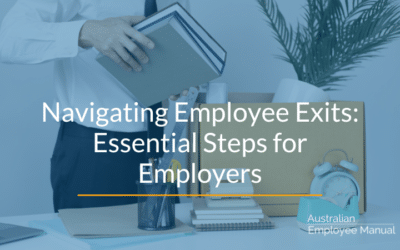You have made it through the interview and hiring process and now have a new employee joining your business. The important part is over, right? Wrong!
New employee induction or orientation is a critical human resource process for the employer and the employee.
What is Employee Induction or Onboarding?
Employee induction, also known as onboarding, is a process that introduces new employees to the company and its culture, values, policies, procedures, and expectations.
An employee induction aims to ensure that new employees feel welcomed, valued, and equipped to succeed in their new roles.
It is usually conducted during the first few days or weeks of employment and provides new employees with the necessary information and training to become productive members of the organisation.
It is designed to:
- Take care of administrative processes required to get the employee on your payroll system;
- Outline your company values, direction, expectations and Code of Conduct;
- Clarify the duties and work requirements of the new role;
- Share key employee policies and procedures for your business;
- Introduce the new employee to your team;
- Take the new employee through essential workplace health and safety training to ensure they can safely perform their duties in the workplace;
- Ensure the new employee knows how to operate the technology or machinery required in your business.
The duration and content of the induction process may vary depending on the company’s size, complexity, and industry. However, the ultimate goal of employee induction is to help new employees feel welcome, informed, and confident in their new role and to ensure they are set up for success in the organisation.
Why Is Induction Important for new Employees?
The first few days in a new job creates a clear impression of what it is like to be part of your business.
The induction process you use and the steps you follow tell your new employee if you are organised, professional and care about your staff. It highlights your work culture and demonstrates if you walk your talk in terms of living your espoused work values.
When done correctly, employee inductions lay a firm foundation for an employee’s future with your business. It helps them quickly get up to speed with their role and become productive team members.
Effective induction:
Reduces anxiety
Starting a new job can be stressful, and induction can help ease new employees’ anxiety by providing them with information about the company, their roles, and the people they will be working with.
Delivers Faster Integration
Induction allows new employees to learn about the company’s values, goals, and culture, which can help them integrate faster into the organisation and work more effectively with their colleagues.
Ensures a Better Understanding of the Job
During induction, new employees learn about their job responsibilities, performance expectations, and how their role fits into the broader company structure. This can help them better understand what is expected of them and how they can contribute to the company’s success.
Improves Retention
High turnover within an organisation can often be linked back to a poor initial induction process. Providing a good induction experience can help to improve employee retention as it shows that the company values its employees and is invested in their success. It also helps to reduce the likelihood of new employees feeling overwhelmed or lost in their new roles.
Increases Productivity
Induction can help to reduce the time it takes for new employees to become productive, as they are provided with the information and resources they need to start contributing to the company’s goals as quickly as possible.
Common Problems with Induction Processes
Some common problems can arise during the induction process, which can negatively impact the effectiveness of the process.
Lack of Preparation
Sometimes, companies do not adequately prepare for the induction process. This can result in a lack of structure, disorganisation, and confusion among new employees.
If your employee has to scavenge for furniture and essential office supplies on their first day of employment, you are sending a clear message that you are disorganised and don’t value the new employee. Have everything ready and waiting for a new employee.
Inconsistency
One employee may get a thorough induction, but the next gets 5 minutes squeezed in between phone calls. This means you have a patchy understanding of expectations across your employment team and can set up unnecessary perceptions of favouritism. Keep your process consistent by using a clear checklist and process.
Information Overload
You have a lot of information that you want to cover in a short amount of time. Trying to cover everything will leave the new employee overwhelmed rather than enlightened. It is like trying to quench thirst with a fire hose rather than simply handing someone a cup of water.
Pace your information out over a few days, providing the most critical information and training first, then gradually introducing additional information over time. Remember to regularly check in to ensure the employee understands what you have been telling them.
Not allowing sufficient time
Many managers spend 10 minutes with the new employee, hand them a pile of information and then disappear to do manager-type work, never to be seen again.
If you are genuinely too busy to spend time with your new hire, allocate them an induction buddy that can answer their questions during the first weeks on the job and take them through the expectations of their new role.
Inadequate Training
In some cases, new employees may not receive adequate training during the induction process, which can lead to poor performance and mistakes on the job. Companies should ensure new employees receive the necessary training to perform their job effectively to avoid this problem.
Assuming knowledge
Managers often forget that processes and equipment are different from business to business. You need to explain how to safely operate all technology and machines in your business. This includes things as simple as where and how to store computer documents through to the operation of more dangerous machines.
Lack of Follow-up
Induction is not a one-time event; companies should follow up with new employees to ensure that they are settling into their roles and that any questions or concerns are addressed.
Poor Communication
Communication is critical during the induction process, and poor communication can lead to confusion, misunderstandings, and frustration among new employees. Ensure all communication with your new employee is clear, consistent, and timely.
Boring and Unengaging
Induction programs that are boring and unengaging can lead to disengagement among new employees. Try to make the induction process as interactive, interesting, and fun as possible to help keep your new employee engaged with the process.
What Should Be Included in an Employee Induction
Paperwork
There is no shortage of paperwork to be completed by the new employee. This includes employment contracts, bank details for pay, superannuation details, tax file numbers, visa copies, drivers’ licence or other licence copies (if operating cars or machinery), the Fair Work Information Statement, and other legislated documents from Fair Work Australia.
Company Overview
Discuss the history of the company, its essential products and services, and key personnel. An organisational chart with photos of key personnel can be useful to get the new employee up to speed on the people in the business.
Company Expectations & Processes
Cover the company Code of Conduct and behavioural expectations, including dress code, timeliness, leave, company benefits, probation, performance and grievance processes.
Position Description
Discuss the duties, reporting relationships and expectations of the role by referring to the position or job description.
Phone and Address Details
How should new employees answer the phone? What is the official street and mailing address for the company? Is there a phone list for direct lines?
Safety and Security
What are the safety and security expectations? What are your fire and first aid processes? What are the expectations around workplace bullying and harassment?
Workplace Tour
Where are key things located in the business (e.g. toilets, lunch areas and fridges, personal item storage, stationery stores, parking/public transport options, places to get lunches in the area)
Meet and Greet
Introduce the new employee to fellow team members and key personnel. It helps to give them a “mud map” of names and contact numbers against desk locations to help them remember who sits where.
If possible, arrange a morning tea or lunch to welcome the person to the team. There is something powerful about informally chatting with people over food to quickly break down barriers and help bring the person into the social dynamic of your team.
Best Practice Tips for Onboarding New Employees
Have a structured onboarding process
Develop a structured induction or onboarding process outlining the steps new employees will go through when they join your organisation. This can include tasks such as introducing them to their colleagues, providing them with training, and ensuring they understand the company’s culture and values.
Ensure that new employees have the necessary equipment and resources
Ensure new employees have the necessary equipment and resources, such as a computer, phone, and access to the company’s systems and databases. This can help them feel supported and empowered to do their job effectively.
Assign a buddy or mentor
Assign a buddy or mentor to new employees who can answer their questions, show them around the workplace, and help them feel comfortable in their new role.
Provide training and development opportunities
Provide new employees with training and development opportunities that can help them improve their skills and knowledge. This can help them feel valued and invested in their role.
Introduce new employees to the company culture and values
Introduce new employees to the company culture and values, including the company’s mission statement, vision, and values. This can help them understand what is expected of them and how they can contribute to the organisation’s success.
Ask for feedback
Ask for feedback from new employees on their onboarding experience. This can help you identify areas for improvement and ensure that future onboarding processes are more effective.
Following these best practices ensures that your new employees feel welcomed, supported, and prepared to do their job effectively. This can help them feel motivated and engaged in their work and contribute to the success of your organisation.
Conclusion
New employee induction should never be an afterthought but a core part of your human resource processes. After all, you never get a second chance to make a good first impression of your business.
Our Instant HR Policies and Procedures Manual and the NDIS Direct Employment HR Manual both include New Employee Orientation Manuals, forms and checklists to help make your inductions fast and effective.




